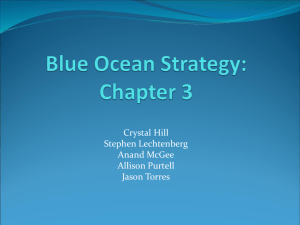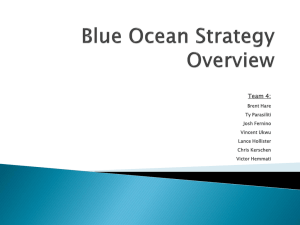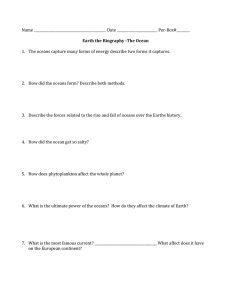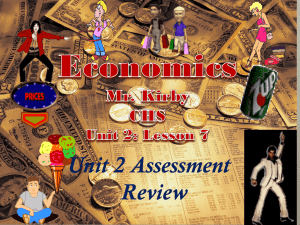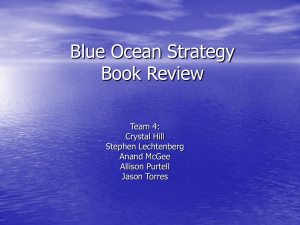Industry Boundaries and Service Offerings
advertisement
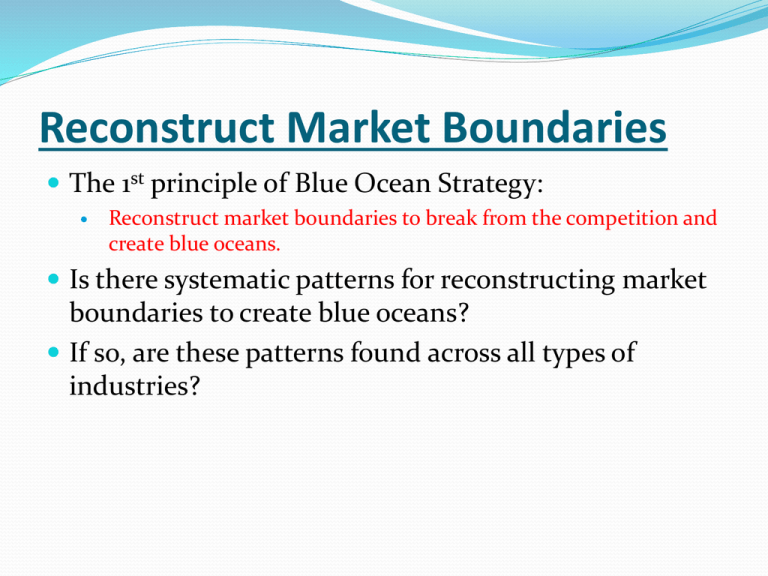
Reconstruct Market Boundaries The 1st principle of Blue Ocean Strategy: Reconstruct market boundaries to break from the competition and create blue oceans. Is there systematic patterns for reconstructing market boundaries to create blue oceans? If so, are these patterns found across all types of industries? 6 Paths Framework Look across: Alternative Industries Strategic Groups Chain of Buyers Complementary Product Offerings Functional/Emotional Appeal Time 6 Fundamental Assumptions 1. 2. 3. 4. 5. 6. Define their industry similarly and focus on being the best within it Look at their industries through the lens of generally accepted strategic groups, and strive to stand out within that group Focus on the same buyer group, be it the purchaser, the user, or the influencer Define the scope of the P&S offered by their industry similarly Accept their industry’s functional or emotional orientation Focus on the same point in time – and often on current competitive threats – in formulating strategy Path 1: Look Across Alternative Industries Substitutes are P&S that have different forms but offer the same functionality/core utility To sort out personal finances you can use financial software, hire a CPA, or use pencil and paper Alternatives include P&S that have different functions and forms but the same purpose Cinemas vs. restaurants Same objective: Enjoy a night out NetJets Created the blue ocean of fractional jet ownership Corporate travelers are the mass of customers in the aviation industry Why do corporations choose commercial airlines? Why do corporations choose corporate jets? Benefits • Own 1/16th of an aircraft • 50 hours of flight time per year • Can fly 4 hours after a request • $375,000 per year plus pilot and maintenance • 30 airports vs. 5,500 • Flight times dramatically shorter Washington D.C to Sacramento 10.5 hours vs. 5.2 hours • You can eat your favorite meals on the plane Results Success has been attributed to its flexibility, shortened travel time, hassle-free travel experience, increased reliability, and strategic pricing There revenues grew 30-35% from 1993-2000 Path 2: Strategic Groups in Industry Blue oceans can be created by looking across alternative industries and strategic groups Strategic Groups- Group of companies within an industry that pursue a similar strategy Ranked in two dimensions Price Performance Example: Mercedes, BMW, and Jaguar Path 2: Strategic Groups in Industry Example: Curves Over saturated market Created veritable blue ocean of women struggling with fitness Advantage on two strategic groups Traditional health clubs Home exercise programs Path 2: Strategic Groups in Industry Example: Ralph Lauren High fashion with no fashion Updated classical look and price capture best of classical lines such as Brooks Brothers and Burberry Combine attractive factors of both groups and eliminate everything else Captured shares from both segments but drew in many new customers Path 3: Chain of Buyers Directly and indirectly involved in buying decisions Purchasers, Users, and Influencers May overlap, but differ in many ways Path 3: Chain of Buyers Examples: Pharmaceutical industry focuses on influencers: Doctors Office Equipment industry focuses on purchasers: corporate purchasing departments Clothing industry focuses on Users Path 3: Chain of Buyers Insulin created blue ocean Helped change pharmaceutical industry from influencers to users NovoPen Patients can easily carry a weekly supply of insulin Inject with ease Innovo Built in memory system to display dose, last dose, and elapsed time Path 3: Chain of Buyers Shifting can create new values to the industry See new ways to unlock value Path 4: Look Across Complementary Product and Service Offerings In most industries, rivals converge within the bounds of their industry’s product and service offerings (vacuum) Costs of complementary goods and services of another product or service are considered when purchasing For example, the theater example Operators should consider babysitting and parking costs for customers Complementary Products “Untapped” value often hidden within complementary products and services Such as JC Penney, customers that buy shoes also need to buy socks Application and Operating software that are used along with computer hardware Key is to define the total solution buyers seek when choosing a product or service What happens before, during, and after product is used Path 4: Applied NABI NABI, a Hungarian bus company, applied path 4 to the U.S. transit bus industry Rivals competed to offer lowest prices Designs outdated, delivery times late, quality low, maintenance costs were high NABI acted on the complementary services Fiberglass, Eco friendly, Low manufacture costs Philips Electronics British tea kettle industry, very important to British culture Flat sales, shrinking profit Lime scale found in water Water supply is complementary service Filter • NABI’s curve, unlike any other before in the industry • By recognizing complementary services, cut costs from corrosion, prevention maintenance, and fuel consumption Path 4: Concepts to Creating a Blue Ocean Redefine Scope of Services B&N from books to intellectual exploration and coffee bars Satisfy customer’s complete demands Virgin Entertainment combine CD’s, video games, stereos, audio equipment Eliminate superfluous costs NABI & Dyson eliminates need for bags Accommodate convenience of customer Zeneca’s Salick cancer centers combine all specialized treatments Path 5:Look Across Functional or Emotional Appeal to Buyers Functional and emotional appeals are embedded within industries Functional- compete on price and function Emotional- compete on feelings of products/services Opportunity for Blue Ocean Functional and Emotional Appeal Switching from Functional to Emotional Example: Viagra and Swatch Switching from Emotional to Functional Example: Quick BeautyHouse JCPenney’s Emotional Appeal Switch from Emotional to Functional Started fashionable Moved towards efficiency Supply chain management Low prices Path 6: Look Across Time External trends affect companies Most act passively and adapt incrementally Trends that have affected companies Example: internet and protecting the environment. Look Across Time Opportunity for Blue Oceans Future Telling? Managers project change Systematic Approach Decisive to business Irreversible Clear Trajectory Example: Apple Napster & Kazaa vs iTunes JCPenney • Traditional Department Store • Overtime Adapted Technology – Self checkout kiosk • Did not necessarily work – Customer demographics • Elderly Conceiving New Market Space Blue Oceans Not about predicting trends Come about through structural process Reconstructing existing market Free from head-to-head competiton
